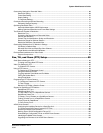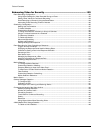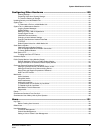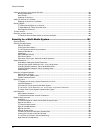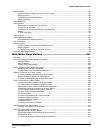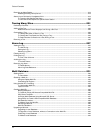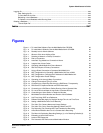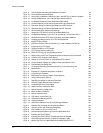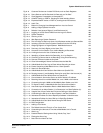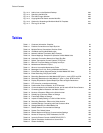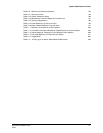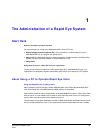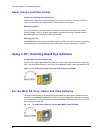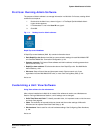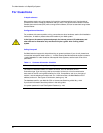
System Administrator’s Guide
Document K14392V1 Rev A 15
07/07
Fig. 8–9.
Customer Devices can Include POS Units, such as Cash Registers. 143
Fig. 8–10. Some Devices can Be Searched for Data such as “No Sale”. 144
Fig. 8–11. Cash Registers, Connected to a Honeywell PIT. 146
Fig. 8–12. A NetPIT Device on PORT 3, Showing All Serial Interface Values. 146
Fig. 8–13. Expanded NetPIT device on PORT 3, showing three POS devices. 147
Fig. 8–14. Audio Tab. 148
Fig. 9–1. Button for Changing User Management from Local to Central. 154
Fig. 9–2. Adding a "Night Operator" Account. 156
Fig. 9–3. Defaults: User Account Rights (1) and Site Access (2). 158
Fig. 10–1. Logging on to SQL-Server Differs from the Log on to Admin. 166
Fig. 10–2. System Password. 166
Fig. 10–3. Securing a Unit. 167
Fig. 10–4. After Removing a System Password. 170
Fig. 10–5. The LVP Utility Is Used only when a Unit Replaces another at a Secured Site. 173
Fig. 10–6. Inputting a Previous Owner’s System Password into the LVP Utility. 175
Fig. 10–7. Assigning Rights to a “Night Operator” Multi-Media Account. 178
Fig. 10–8. Summary of a User’s Rights on the Users Tab. 179
Fig. 10–9. Account's Limit on Session Time, before Needing to Reconnect. 183
Fig. 10–10. Limiting an Account’s Use of Cameras at a Site. 184
Fig. 10–11. Identifying a Camera that is Not Recording, in a Live Session. 185
Fig. 10–12. Overriding a Camera that is not Recording, Using Event Recording. 186
Fig. 10–13. Sources of Events Include the Unit itself. 187
Fig. 10–14. Once Acknowledged, Alarms Are Entered into the Multi Db. 188
Fig. 10–15. A Multi-Media Unit Can Log an Event without Sounding an Alarm. 189
Fig. 10–16. Events Caused by a Multi-Media Unit or a View Operator. 192
Fig. 10–17. Search for Events Window. 193
Fig. 10–18. A Multi-Media Unit Can Be Set to Send Alarms to Specific PCs. 195
Fig. 10–19. Denying Access (1) and Updating Security for each Site in the Account (2). 198
Fig. 11–1. A Multi-Media Unit Can Send Alarms to a Specific PC. 201
Fig. 11–2. Over a Network, Alarm's Are Sent to an Alarm Station’s IP Address. 205
Fig. 11–3. Receiving Alarms from a Multi-Media Unit, over a WAN or the Internet. 206
Fig. 11–4. Connecting through a WAN to a Multi-Media Alarm Station on a LAN. 207
Fig. 11–5. To Report an Alarm, a Multi-Media Unit Can Call an Alarm Station. 208
Fig. 11–6. Area Code Input Is Needed to Reach a Multi-Media Alarm Station. 209
Fig. 11–7. Connection for an Alarm Station (1) Is Shown also in a Site's Definition (2). 210
Fig. 11–8. Irregular Use of Area Codes when Units Are Calling an Alarm Station. 211
Fig. 11–9. Customizing the Dial-up to an Alarm Station in the Site’s Definition. 212
Fig. 11–10. International Prefixes for Use of Rapid Eye Software in North America. 214
Fig. 11–11. International Prefixes for Use of Dial-up in Rapid Eye Software. 215
Fig. 11–12. A Multi-Media Unit Can Send Alarms through a RAS Server. 216
Fig. 11–13. RAS Configuration. 216
Fig. 12–1 . Adding a Tour Name. 222
Fig. 12–2. The Default Amount of Time for a Tour of each Unit. 223
Fig. 12–3. Customizing the Amount of Time that a Multi-Media Unit Is Toured. 224
Fig. 13–1. Alarm Log 227
Fig. 13–2. Possible Result of Sorting when Using “Month, Day, Year”. 228
Fig. 13–3. Filtering the Alarm Log. 229
Fig. 14–1. Data Flow from Admin to View. 231



